What Is A Timeless Fireplace Surround?
A fireplace surround, also known as a mantel, is the decorative frame that surrounds a fireplace opening. Fireplace surrounds have existed for centuries and originally served the functional purpose of catching smoke and directing it up the chimney flue. Over time, fireplace surrounds evolved into decorative architectural elements that contribute to a room’s style.
This article will provide an overview of the history of fireplace surrounds, including their origins, evolution of styles over time, considerations for installation, maintenance, costs, and current trends. We’ll explore what makes some fireplace surrounds truly timeless designs by examining materials, aesthetic styles, and quality craftsmanship that withstand the test of time.
Purpose
The main purpose of a fireplace surround is functional and aesthetic. It serves to frame and finish the fireplace opening, providing an attractive border that complements the masonry or materials around the firebox. Surrounds help delineate the fireplace zone and make it stand out as a focal point in the room.
Functionally, fireplace surrounds protect the wall around the fireplace from heat damage and discoloration. They provide a buffer zone between the intense heat of the fire and surrounding walls. Materials like stone, brick, and metal can withstand high temperatures and prevent scorching or smoke stains on drywall above the fireplace.
Aesthetically, the fireplace surround creates an eye-catching architectural feature and opportunity to add style. The surround frames the fireplace and ties together the materials used in the hearth, mantel, and facing. Surrounds range from classic styles like marble or granite to more modern looks using tile, slate, or metal. The design choices are endless, allowing homeowners to match their décor.
In summary, fireplace surrounds serve the dual purpose of protecting walls from heat damage while providing decorative embellishment around the firebox opening. They enhance the ambiance and visual appeal of the fireplace as a whole.
Sources:
https://www.stovesareus.co.uk/blog/everything-you-need-to-know-about-fireplace-surrounds
Materials
The most popular and timeless materials for fireplace surrounds include natural stone, wood, tile, metal, and concrete.
Natural stone like marble, granite, limestone, and slate have been used for centuries to create elegant yet durable surrounds. The natural beauty, variety of colors and patterns, and ability to withstand heat make stone a classic choice (source).
Wood surrounds provide a warm, rustic feel in any style from traditional to modern. Woods like oak, pine, cedar, and walnut not only look beautiful but can be carved into custom designs. It’s important to properly seal and care for wood to handle the heat exposure (source).

Ceramic and stone tile lend themselves to creative patterns and colors for one-of-a-kind surrounds. Tiles must be heat resistant and properly grouted. Popular options include ceramic, porcelain, slate, and stone tiles.
Metals like steel, iron, and copper offer an industrial, modern look. They can be crafted into custom shapes and stand up well to high temperatures. Blackened steel is especially on trend.
Concrete and stucco fireplace surrounds provide a smooth, seamless appearance for contemporary styles. Concrete can be customized with pigments, textures, or etchings and delivers durability.
Styles
There are three main styles of timeless fireplace surrounds: traditional, modern, and rustic.
Traditional
Traditional fireplace surrounds feature classic and elegant designs often made from natural stone like marble or manufactured materials like cultured marble. They have clean lines, symmetrical shapes, and ornate decorative details like columns, arches, molding, and carved accents. Traditional surrounds pair well with formal furnishing styles and exude a sense of permanence and luxury.
Some examples of traditional materials and looks include white Carrara marble, grey soapstone, polished limestone with inlaid designs, dark wood molding, and painted finishes with gold leaf accents. This fireplace surround demonstrates a formal traditional aesthetic with its curved pediment framing, fluted pilasters, dentil molding, and marble construction.
Modern
Modern fireplace surrounds have clean, straight lines and often incorporate metal, concrete, stone slab, or wood paneling. The designs are unfussy and sleek, sometimes with asymmetric elements. Modern surrounds work well in contemporary homes and lofts and can act as a striking focal point.
Some hallmarks of modern styles are stainless steel frames, stone veneer facades, metal mesh screens, floating shelves, and reclaimed wood planking. This example shows a minimalist concrete surround with a smooth stone front and hearth.
Rustic
Rustic fireplace surrounds use natural, unfinished materials like raw wood beams, uneven stone, or exposed brick. They have an informal, organic look that creates a cozy, welcoming feel perfect for a cabin, cottage, or farmhouse. Rustic surrounds match furniture made from reclaimed wood, iron, or leather.
Common rustic elements include distressed wood mantels, stacked flagstone, river rock walls, and textured slate. This fireplace features a surround made from antique barn wood with chipped paint and visible nail heads to embody rustic style.
Considerations
When selecting a fireplace surround, it’s important to consider the size of your fireplace opening and the overall decor of the room. You’ll want to choose a surround that fits properly within the fireplace opening and complements the existing style and finishes of the space.
According to House Beautiful, take measurements of the height, width, and depth of the fireplace opening when shopping for a surround. The surround should overlap the opening by at least 2 inches on each side. Consider traffic flow around the fireplace and allow enough clearance for furnishings. An oversized surround can make the fireplace opening appear smaller.
The material you choose for the surround should coordinate with your room’s decor. Stone and tile surrounds come in a variety of natural colors and patterns that can match traditional or contemporary design schemes. Metal and wood surrounds offer sleek, modern options. Studio DK recommends selecting materials and colors that tie into other finishes in the room, like flooring, wall colors, and furnishings.
Durability is also an important factor, especially for active households. Tile, stone, brick, and metals like steel can withstand high heat and frequent cleaning. According to MaxSpace Stoneworks, natural stone is very durable but can be prone to cracking from heat exposure over time. Metals and tile may be better choices for fireplaces with higher heat output.
Installation
Installing a timeless fireplace surround can be done as a DIY project or by hiring a professional. According to https://www.mantelsdirect.com/blogs/guides/fireplace-surround-facing-kits-installation-instructions, a DIY installation is definitely possible for most homeowners but does require some construction skills. Key steps include preparing the hearth, measuring and cutting materials, securing the surround to the wall, applying adhesive, and sealing gaps.
Hiring a professional installer can make the process significantly easier but does come at an added cost. Pros are experienced with safely lifting and securing heavy surround materials like natural stone or solid wood. They also have the right tools to achieve a precise fit and finish. On average, professional installation costs $2000-5000 depending on the size and material of the surround.
Whether DIY or hired out, proper installation is crucial to ensure the fireplace surround is securely mounted and sealed. Taking the time to do this right will pay off in added safety, longevity, and aesthetic appeal.
Maintenance
Proper maintenance is crucial for keeping your fireplace surround in good condition. This involves regular cleaning, sealing, and repair as needed.
For cleaning, it’s important to remove any built up soot, dirt, and debris from the fireplace after each use. Use a soft brush or vacuum to gently remove residue from the firebox and chimney. For the surround itself, mix a solution of equal parts white vinegar and water and wipe down all surfaces with a sponge or cloth. For stubborn stains, a commercial fireplace cleaner like Rutland Fireplace Glass Cleaner can help lift grime.
Sealing your fireplace surround will help protect it from smoke and moisture damage over time. Use a high-heat silicone caulk to seal any cracks or gaps. Refractory mortar can be used to repair damaged mortar joints in a masonry surround. Metal surrounds may need to be painted or re-coated periodically to prevent rust and corrosion.
Inspect your fireplace surround carefully each year and make repairs as needed. Loose or missing grout, cracked tiles, peeling paint, or rust spots should be addressed right away to prevent further deterioration. With regular maintenance and care, your fireplace surround can stay beautiful for many years.
Costs
The cost of installing a fireplace can vary greatly depending on the type of fireplace and materials used. According to HomeGuide, the average cost to install a fireplace ranges from $1,050 for a basic gas fireplace insert to $3,780 for a custom wood-burning fireplace and chimney system.1 The major factors that affect fireplace installation costs include:
- Type of fireplace – gas, wood-burning, electric, etc.
- Materials like stone, brick, marble, tiles, and mantels
- Labor for construction and installation
- Chimney or venting requirements
According to Bob Vila, a basic manufactured gas fireplace unit can cost $500-2,000 not including installation. Custom wood-burning fireplaces typically range from $3,000-30,000 or more for high-end stone or brick surrounds.2 Angi reports the average professional installation cost for a fireplace is around $2,438.
The cost of materials like stone, brick, tiles, and wood can significantly impact the total project cost. Stone or brick surrounds often add $5,000-15,000 to the total. Luxury materials like marble can cost $100-200 per square foot installed. The mantel is another area where material choices make a difference, with stone or reclaimed wood mantels costing over $1,000 in some cases.
In terms of labor, most projects require masons, framers, plumbers, and electricians which can add $40-100 per hour. A general contractor may also be required to oversee the entire installation process. Permits and inspection fees typically add a few hundred dollars as well.
Trends
Some of the most popular fireplace design trends in 2023 include minimalist, two-tone, and integrated storage styles.
The minimalist look is characterized by clean lines, an absence of ornamentation, and neutral colors like white, black, or gray. This creates a contemporary aesthetic that blends seamlessly into modern decor (HGTV). Minimalist surrounds often use materials like stone, metal, concrete, or wood in simple, geometric shapes.
Two-tone fireplace surrounds mix different textures and materials, like combining wood beams with exposed brick. The contrast makes the fireplace a standout focal point. Black steel surrounds paired with white walls and mantle is one popular two-tone look (Acucraft).
Integrated storage, like mantles or surrounds with built-in shelving and cabinets, is on-trend. This allows the fireplace to multitask as display space for books, collectibles, or media equipment. Concealed storage keeps clutter out of sight but close at hand.
Conclusion
In summary, a timeless fireplace surround is one that stands the test of time with its classic, enduring style. Opting for natural stone like marble or limestone, or materials like brick, wood beams, or ceramic tiles in neutral colors will ensure your fireplace surround complements your home’s decor for years to come. Focus on simple lines and symmetrical shapes for a look that won’t go out of style. Consider your lifestyle and maintenance requirements as well to choose the right materials. Work with a professional installer for proper setup. A quality timeless fireplace surround adds character, warmth and charm to any home.
When selecting a timeless fireplace surround, focus on natural materials that have longevity, and choose a simple, classic style. Proper installation and maintenance will keep it looking beautiful for decades to come. With a timeless fireplace surround anchoring your living space, you’ll have a focal point that enhances your home’s ambiance and grows more lovely over time.





